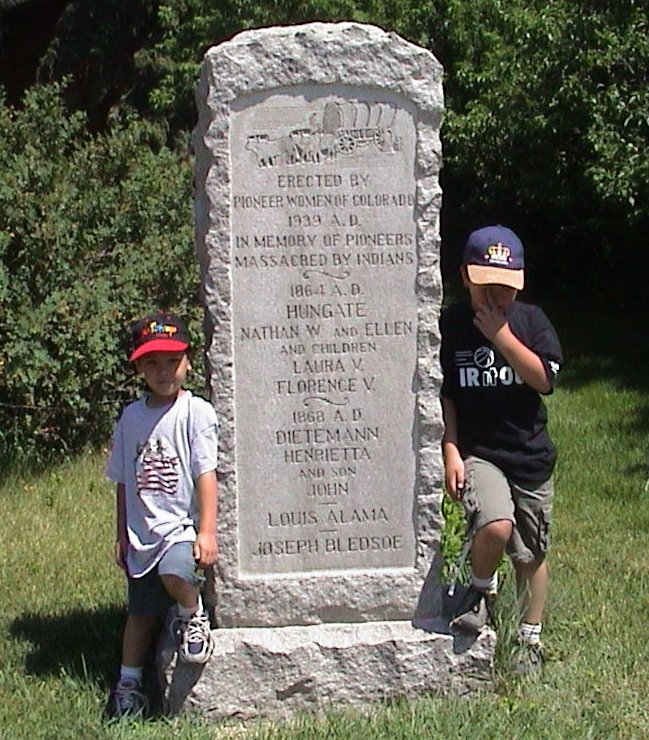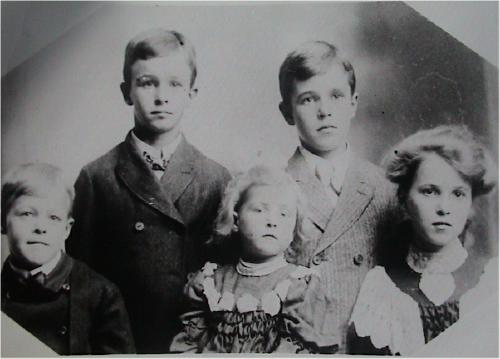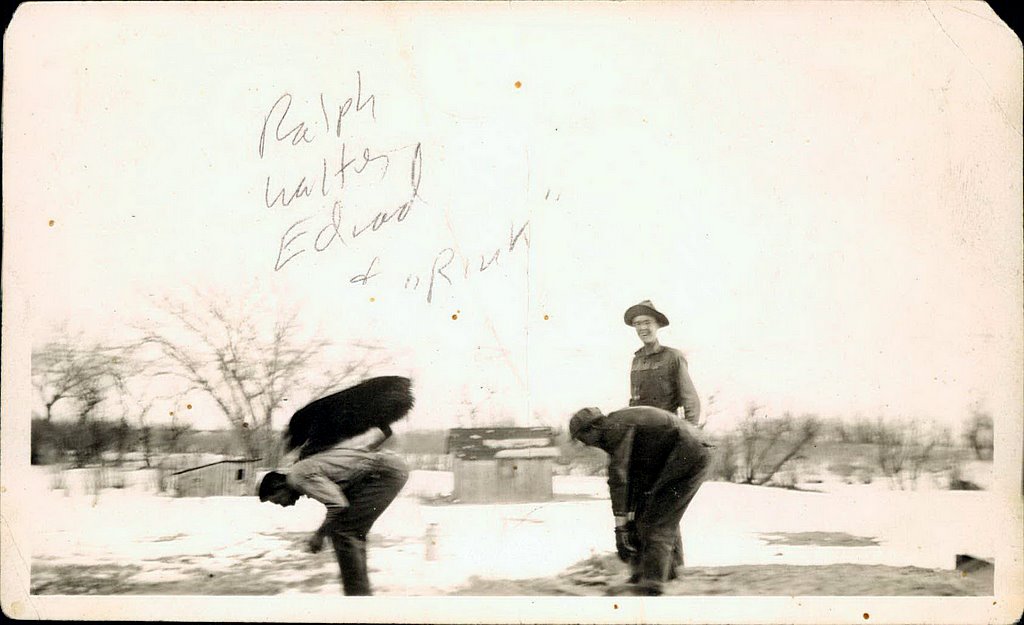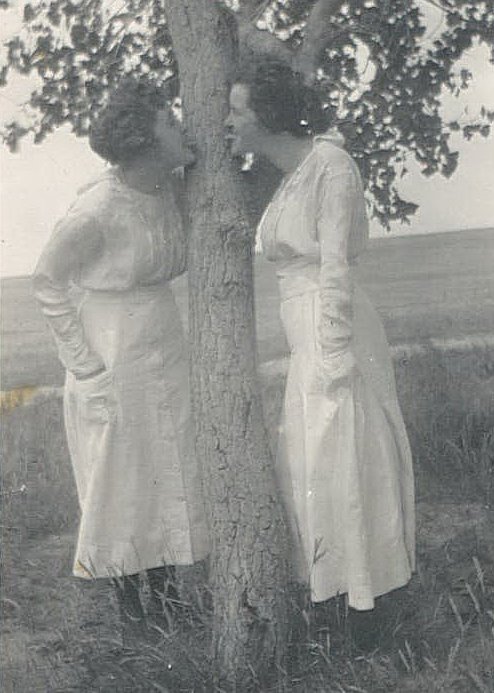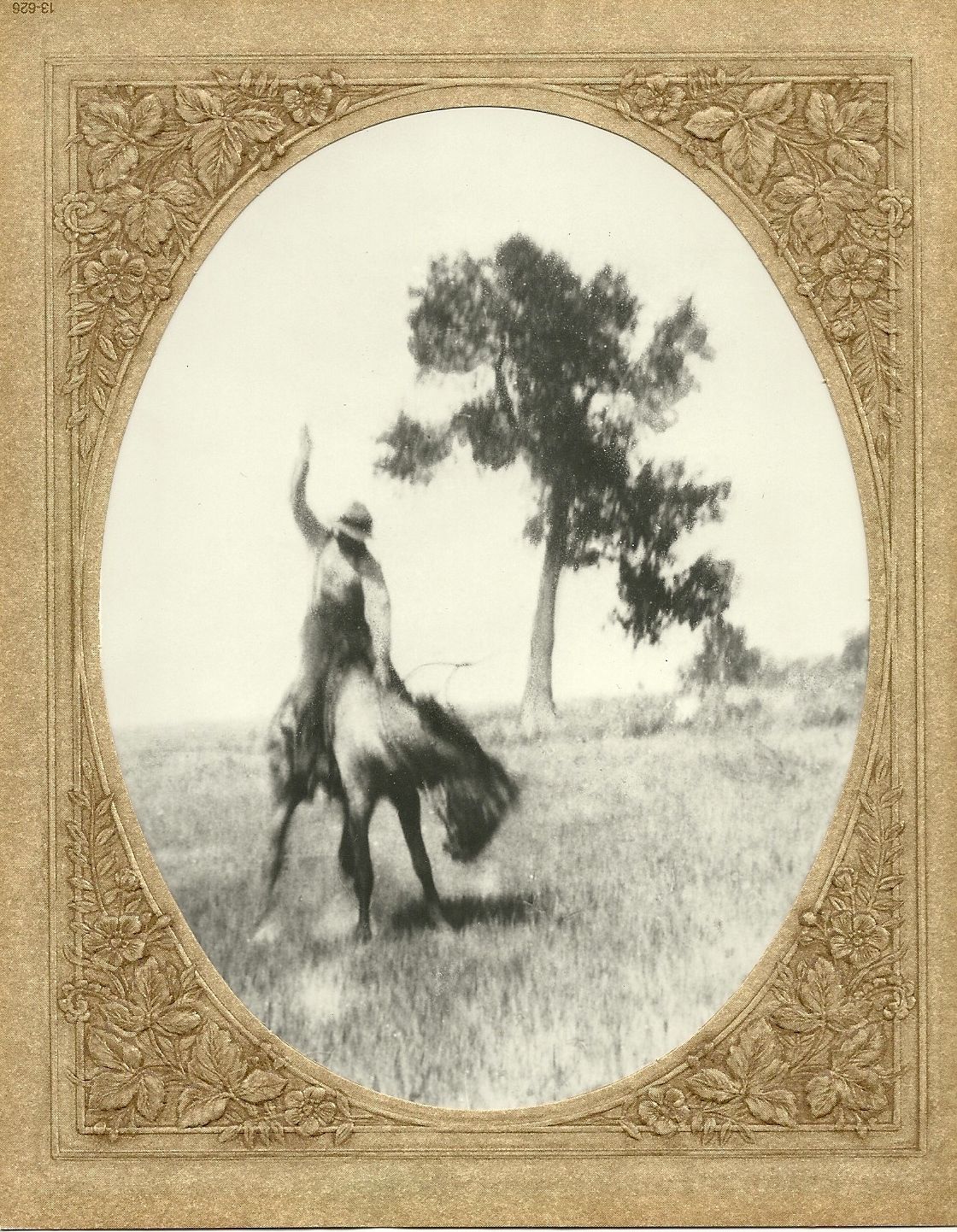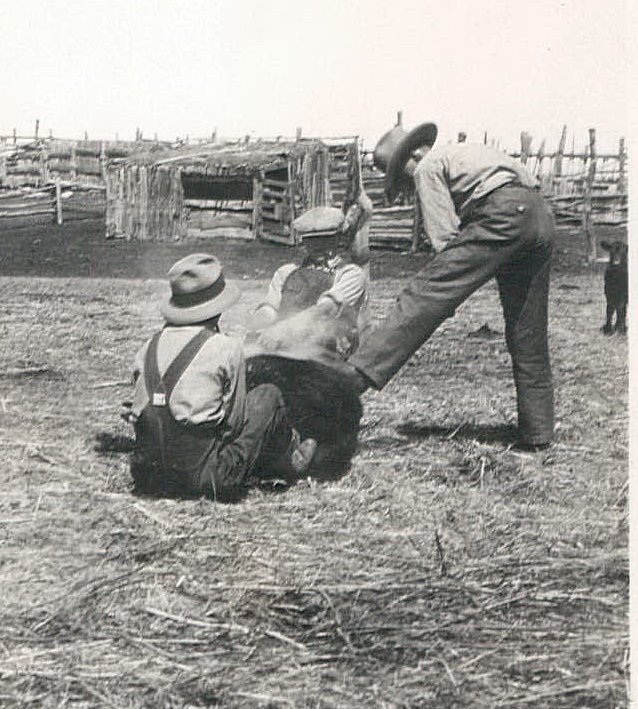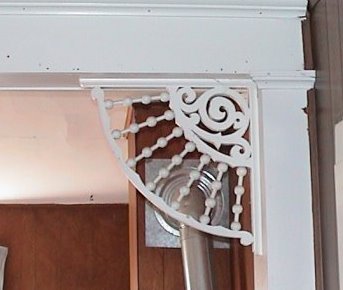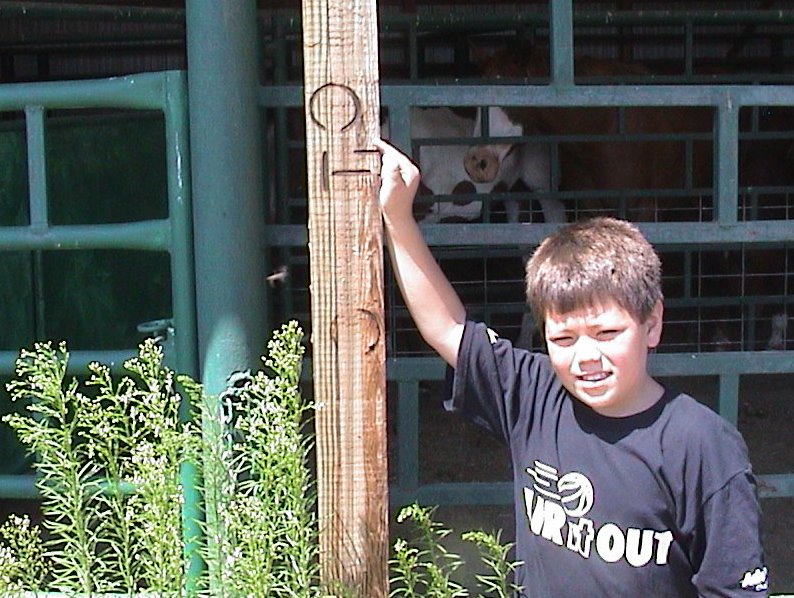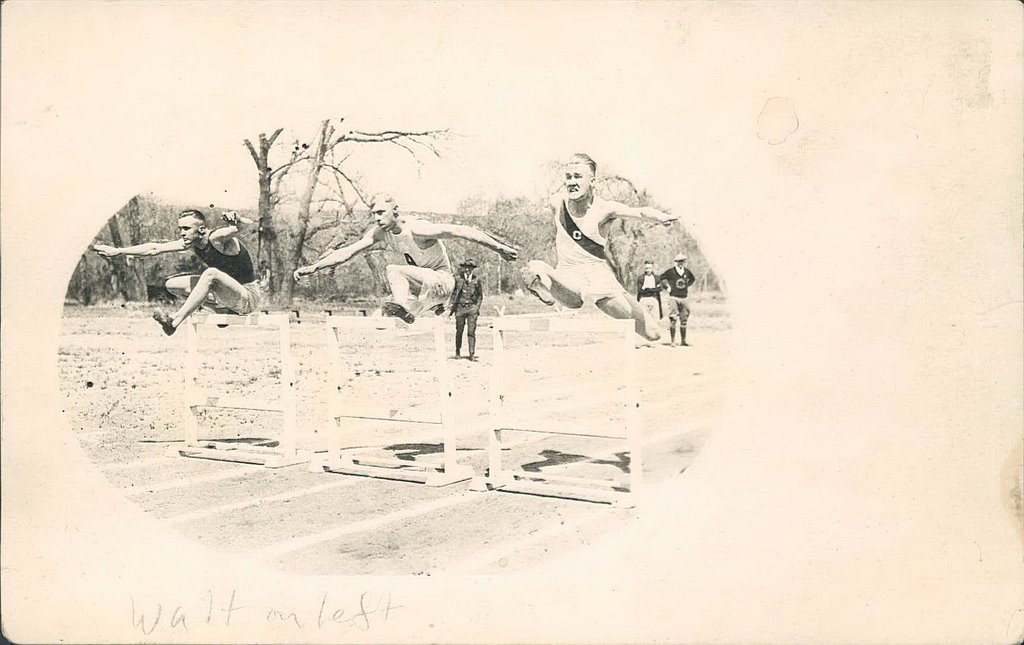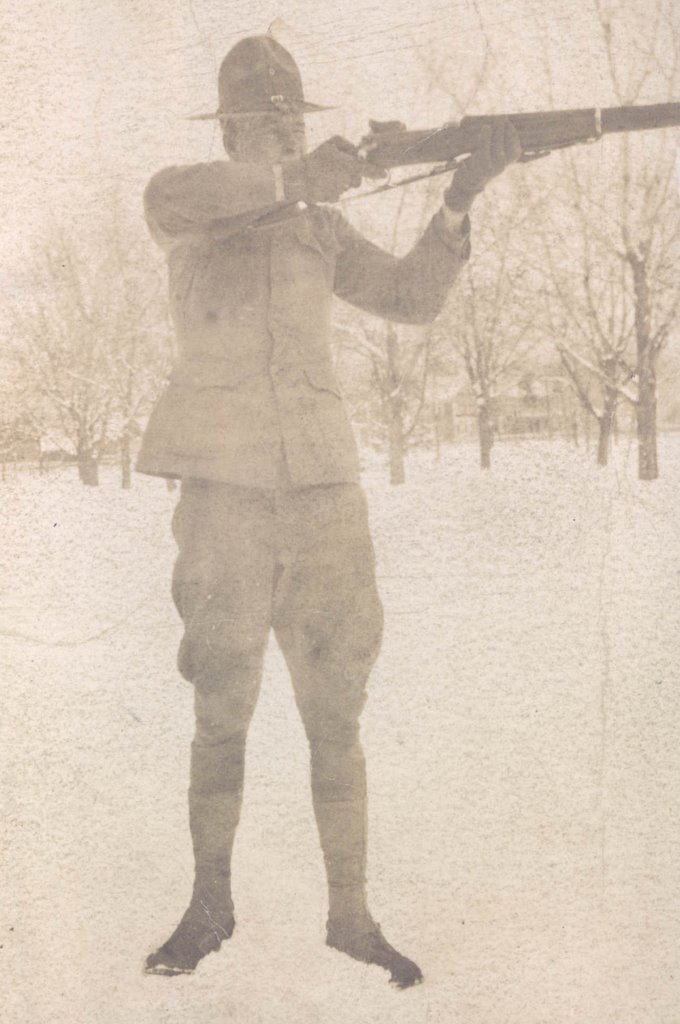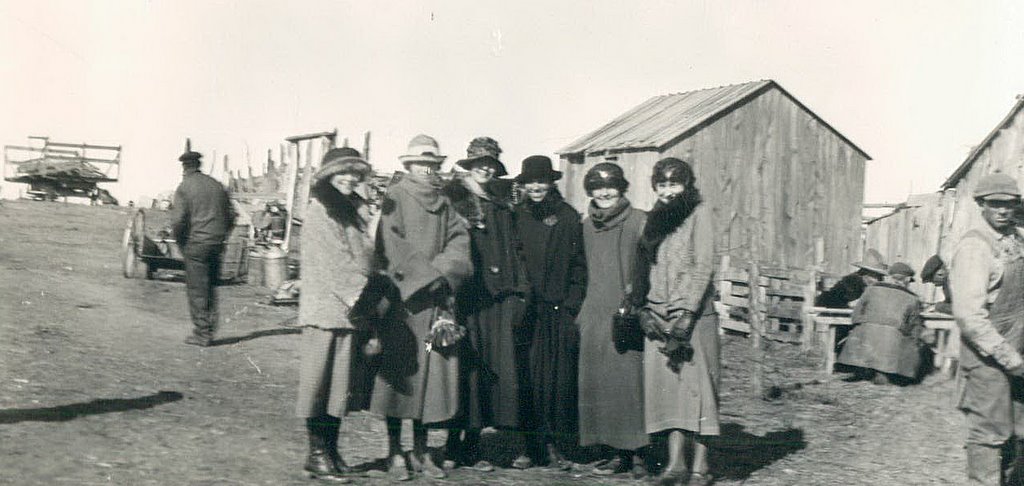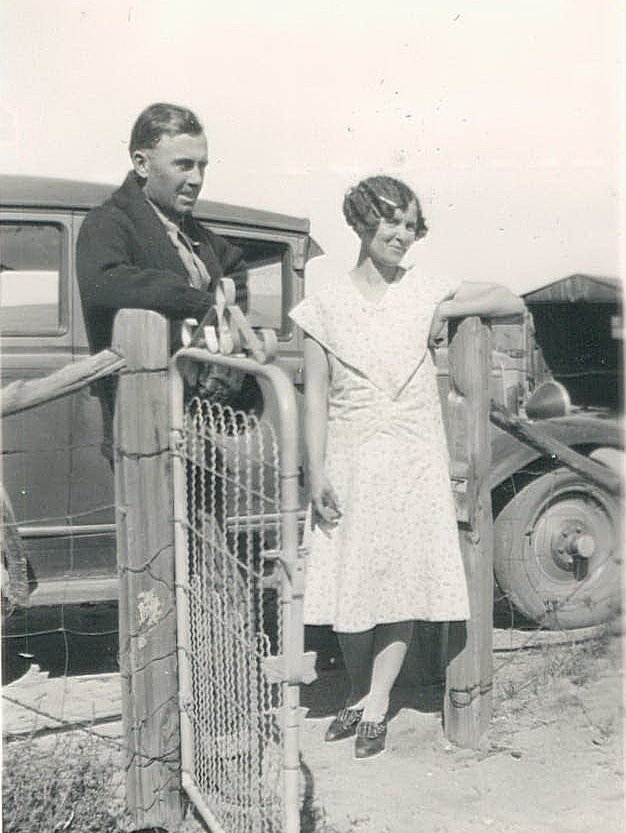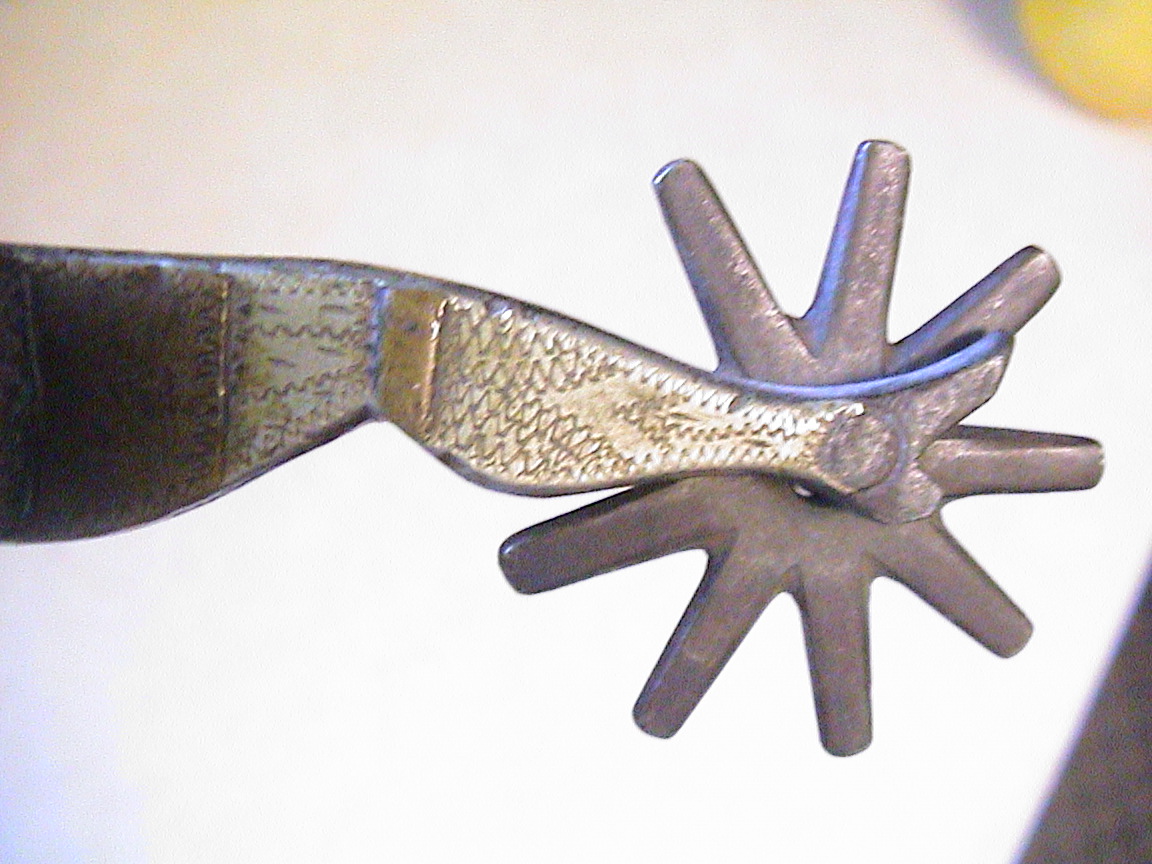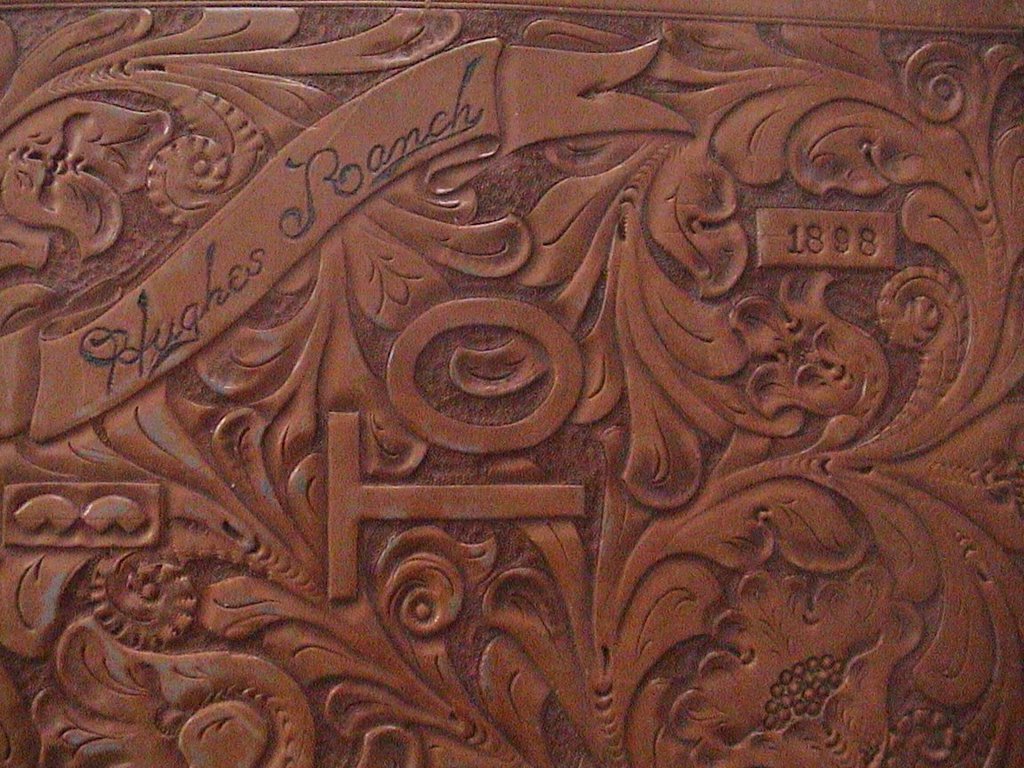EARLY HUGHES FAMILY AND RANCH LIFE
The main chapters of the Hughes Family in Colorado really started after Eben and Ellen Hughes homesteaded their ranch in 1898, raised a fine family, and lived there until the ranch was sold in 1940.
Homestead Location
The Hughes ranch could be reached by driving 4.7 miles east of Kiowa (which is east of Castle Rock and Elizabeth) on Colorado 86 across Comanche Creek, and then 10 miles north on County 61-69 Road parallel to the Creek to our gate with its cattle guard and mailbox right at the intersection of County roads 61-69 and 166. Below is a rough map (but from Elbert County official records) of the original 1898 homestead (#1) below to the last, 1940, acquisition (#9) of Hughes Ranch Property.
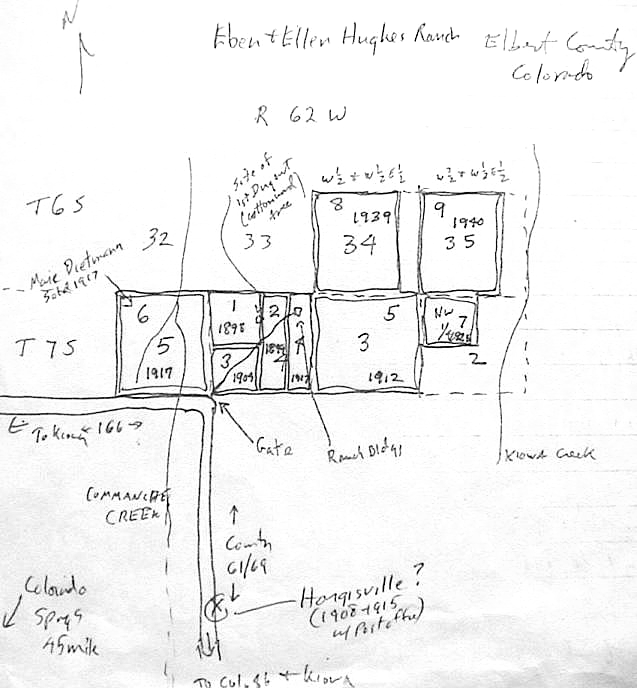 |
|
The Hughes Ranch as it started with the Homestead (1) 1898 through the last acquisition in 1940 (9) 3,000 total acres |
dThe
The
The Comanche Creek flows south from the divide between the Platte River - to the north of the ranch - and the Arkansas River basin to the south. Comanche Creek was named after the Comanche Indian Tribes who ruled the plains when only Spanish explorers ranged, up until the 1770s, when Juan Batiste de Anza, Governor of New Mexico, decisivly defeated them south of Pueblo in 1778 at the battle of Greenhorn.
Then the Cheyenne and Arapahoe tribes filled the vacuum and tried to rule the plains of what became Kansas and Colorado Territories right through the start of the Gold Rush of 1858. But the Indians committed so many depredations of isolated settlers and their homesteads (such as the Hungate family Massacre) - and more importantly they had by 1863 so effectively halted covered and freight wagon travel to Denver, Colorado City and even Pueblo and Canon City - that there was a desperate effort in 1864 - ordered by both the Territorial Governor and Federal Army General Price in Kansas, for Colonel John Chivington to undertake the Battle of Sand Creek in Southeastern Colorado to punish and deter the marauding Cheyenne and Arapaho tribes from more depredations and settler killings.
Some superficially call that engagement the 'Sand Creek Massacre.' Though I - for 30 years a student of the Indian Wars in Colorado Territory that my Colorado schools never taught me - know that with 24 soldiers killed and 52 wounded the myth that only Indian women and children were helpless victims of the planned attack was totally false. It was a two sided battle in which the damage done to the Indians was richly deserved.
Those whose only knowledge of Colorado History starts with the founding of Colorado Springs in 1871, had no relatives killed by those tribes or ranches destroyed have no idea the threat and fear by settlers of the hostile Indian tribes and their actions.
Nevertheless the intended deterrence of further attacks in 1864 did not work that well. For 30 years before the Hughes homesteaded right next to Comanche Creek - in 1868 and 3 years after Sand Creek - a tribe of Arapahoe Indians ran down, killed, and mutilated Henrietta Dietemann and her 5 year old son close to where the Hughes family homesteaded. It was called the 1868 Dietemann Massacre that was part of the Indian Wars that afflicted early Colorado Territory. A monument was erected and still stands in Kiowa, Colorado, the closest town to our Elbert County ranch. Here it is.
|
|
| The List of Indian Massacres in Elbert County |
Young Justin Hughes and David XIII, great grandsons of the Hughes ranch settlers, on a 2005 trip to the Ranch to teach them about their ancestors. Their Aunt Rebecca, my daughter, was with us too on that trip.
As our cattle ranch grew, Eben Hughes was able to buy one section of land (1 square mile of 640 acres) right on the same Comanche Creek in 1917, from a surviving relative of Henrietta Dietemann.
Life on the Ranch
Our ranch with its Lazy O/T cattle brand became a family icon. For not only was it successful as a cattle ranch it grew, through other homestead filings and purchases, from the original 160 homestead acres filed by Eben Hughes, to over 3,000 acres by the 1940s when it was sold, first to the Hatch Family who then sold it to the Phipps Family of Denver. Phipps made it into a contract-cattle ranch, which it still, in 2011, is. No family lives there now only hired hands and a ranch manager (native of Argentina.)
|
|
| The Eben. Ellen Hughes Children about 1907 |
Pictured around 1907 - right to left . Leila (oldest) Edward, Mary(youngest) Walter, and David Ralph, my father.
While Ellen and Eben obviously spoke Welsh around the children as they were growing up, Eben having grown up in America had mastered English with outsiders. Ellen learned it at her schools in Wales. She knew both languages. But one humorous incident happened that underscored the problem a two-language household founded by immigrants encountered. When Edward and Walter first attended elementary school in Kiowa, 15 road miles away, they came home the first day complaining that the children were not speaking “English”. The two boys were confused – the Kiowa children were, of course, speaking English, while the boys better knew Welsh. But they thought Welsh was ‘English!’
|
|
| The entire Hughes Family, including 'Uncle William' about 1910 |
Above is the one best early (1910) photograph of the entire Hughes Ranch Family - including (on his horse) 'Thomas John William' a cousin of both Ellen and William - 'Uncle Will.'
From left to right are Eben, Leila, Mary, Ellen, Ralph (my father), Edward, and Walter. And Betsy their dog.
|
|
| My Dad - David Ralph- with cattle at our barn - Ranchouse visible in background |
Those two key buildings were there from the beginning of the ranch until it was sold in 1940.
The three boys grew up learning hard work, Christian values, doing chores, and tending the livestock that ranged across the growing ranchland, that was their family income.
|
|
| Brothers Ralph, Walter, Edward as teens. And dog Rink |
|
|
| Sisters Mary and Leila |
|
|
| My Dad breaking a horse |
|
|
| Branding Time |
While all five children helped run the ranch through their teen years the older boys, Edward and Walter proved they were developing into real athletes. Edward actually taught school in Elizabeth and coached its sports teams.
|
|
| As the old 1898 Homestead House as it stood in 2005 - with great, great Grandsons David and Justin in front. It was 107 years old. |
It was scheduled to be torn down by orders of Elbert County Government in 2007 as not being sufficiently 'up to code' to house contract ramchers. But it was still up in 2016. A more modern home for the ranch manager was built close by - you can see it to the left.
The original ranch house had a storm cellar (tornadoes were well known on the plains) which was also the closest they got to cold storage for the canned goods the girls and their mother Ellen produced. As a boy spending summers on the ranch I churned butter on the back porch and was fascinated watching a prarie dog which had an endless wheel to run on in its cage,
|
|
| Interior Ranch House detail |
Original detail from the inside of our Ranch House, that I saved on my last visit to it in 2005.
Interestingly enough, after the Hatch’s - and Phipps who bought the ranch after 1940 - kept the original 1898 Hughes Lazy O/T brand with one modification. They added a short bar beneath the O. So the Lazy O/T brand became the O Bar Lazy T brand. Which 111 years later still is the marking on the cattle on that ranchland.
|
|
| David XIII pointing to the Brand with Bar |
On their 2005 visit the big biting horseflies really spooked David and young Justin. They never lived 'where the buffalo roam.'
Family Disperses
World and national events caused all of the family to take divergent paths after our ranch reached its productive peak around 1920.
The ranch did well enough that both Edward and Walter were able to go to Colorado Springs to attend Colorado College in 1914 - a very well regarded small Liberal Arts college, with a reputation also for athletic excellence for its size. Both Edward and Walter starred on both the Football and Baseball teams. And played Basketball and ran Track. In fact the St Louis Cardinals tried to get them both to join the Cardinals. But wiser heads knowing the value of a really good education prevailed. Instead they graduated in 1918. That was during the first World War. All three boys were drafted. Their status was like ROTC. They were not shipped overseas, but could complete their last year of education.
Edward pursued a Business Major degree at Colorado College.
|
|
| Edward warming up |
|
|
| Walter on left at a Colorado College track meet |
My father, the youngest David Ralph also was given a brief opportunity to attend Colorado College several years behind his brothers. He was there one semester between September 10th, 1918 and January 4th, 1919. He took a few classes, but he too was drafted, and he terminated his few classes. The war was over - the November Armistice - while he was at CC. He never graduated.
|
|
| My Father as a Soldier |
The only picture of my father, David Ralph after being drafted for WWI Service. He never went overseas.
One of my Father's Experiences
Reminiscent of the dangerous snowstorms that can sweep the Colorado Plains, my father and another man were trapped in a blizzard out on the plains in 1915 when he was 17, while driving Hughes cattle to market. They had to try and make it to a farmhouse for shelter. When they got there the man of the house refused to let the freezing men sleep in his home. Nor would he let them put their cattle in his barn. He only let them sleep in the Barn. Which they did, one wearing the one good coat between them sleeping while the other stood moving constantly to keep warm until morning. They very nearly froze.
My father reminisced years later to the teen aged daughters of Helen - his wife who had two girls - Dorothy and Jeanne - by her prior marriage before I was old enough to understand it, when a similar ‘Townsend Tragedy’ happened on the Colorado Plains in the 1920s. Townsend drove a school bus when it got caught and stuck in a raging blizzard. The young children were trapped and getting ever colder when he tried to leave the bus to get help, but was found frozen to death hung on a barbed wire fence just a few hundred yards from a farm which he could not see. Two children on the bus died that night.
According to my half sisters, Dorothy and Jeanne, my father wept when he saw that Townsend was the same man who had turned he and his companion away years before. Rather than mutter something like ‘Deserved it’ their 'Daddy Ralph' was a compassionate man. He loved and cherished children, including the two that were not his own, and wept for the lost children on the unforgiving Colorado plains, never criticizing the man who turned him away in a deadly snowstorm.
The Ranch Family Matures
Eben Hughes prospered raising cattle and expanding his ranch over the 20 years after homesteading there. His reputation for business acumen and public affairs judgments grew among Elbert County ranchers. In 1920 he was elected Representative from Elbert County in the Colorado State Legislature.
During the 23 years Ellen and Eben lived on the ranch raising their children, Ellen began to be a follower of Mary Baker Eddy, and embrace the Christian Science religion rather than Methodism which Eben’s father practiced. I long wondered whether her adopting Christian Science came from her being cured of her physical problems by little more than Colorado clear air along with the self-confidence her prayer gave her, more than from any traditional medical treatment. In any event embracing Christian Science, with its rejection of modern medicine had good and bad Hughes Family consequences years later. All three boys - Ed, Walt, David - embraced Christian Science as their religion.
The first family tragedy struck in 1921 when Eben Hughes died from a massive heart attack at age 54, leaving only Ellen, Leila, younger Mary, and sometimes my father David Ralph to manage the ranch. By that time Ed and Walter had left the ranch after college graduation to make their way in the world seperately.
Lots of Hughes Ranch equipment and stock had to be auctioned off. The ranch income dropped greatly. That is why my dad could not continue his college education.
|
|
|
|
| Two Views of the Auction Day on our Ranch after Eben Died |
Change of Ranch Operation
Grandmother Ellen could not handle the ranch alone, even with hired help and Ralph, who also left. Aunt Leila the oldest Hughes child married Ray Snyder after Eben died .
So Leila and Ray stayed on and ran the ranch right up to 1940 when all the Hughes holdings were sold. First it went to a Hatch family, who then sold it to the wealthy Denver Phipps family who turned it into a contract cattle ranch.
All three boys had left our ranch by then. Ray and Leila worked on their own ranch for several years, and Ray became Simla's Postmaster for a time.
|
|
| Leila and Ray Snyder |
My father gave Ray Snyder a pair of spurs, famous in Texas, in the shape of a womans leg for a wedding present. After Ray died in the 1970s his family gave them to me.
|
|
| Uncle Ray's Wedding Spur |
The Snyders then moved back onto the Hughes Ranch and managed it until it was sold in 1940. And 'Mama Hughes' as Ellen was known by all her children was moved to Colorado Springs and given a room in Ed and Arleen's Wood Avenue home as she aged. She became a Christian Science Practitioner.
The Snyders had no children. But gentle Leila was loved by all her nieces and nephews who, from time to time stayed, especially in the summer, at the ranch. We still have a beautiful family leather scrapbook Leila hand tooled and filled with photographs dating from the time all the boys were still on the ranch - 1910 or so - until the early 1940s when the last picture in the scrapbook shows Walter pictured with his wife as he in an American US Army Officer's in WWII. The Brand and year of the Homestead is engraved on the cover.
(Important Note: There were over 300 small black and white photographs in the album. Several key ones are included here with this narrative. But all 300, including whatever was written on the backside of the individual pictures, will progressively be added to the online digitally archived and publically accessible 'Hughes Collection' of all the scores of thousands of photos, documents, maps, writings covering all 83+ years of my life and works, titled 'The Dave Hughes Legacy'. Son David is doing the technical work, which will never be finished since all branches of the Hughes family down through the present 5 grandchildren and 4 great grandchildren - who are already digitially savy are being urged to 'continue' the Hughes family story, online, forever. Credit goes to Daughter Rebecca for much of the genelogical research shown here, and to Cousin Ann Benwell, of Menai Bridge, Anglesey, Wales for her contribution to the Elin Jones Family history in Wales, and for Welsh-to-English Translations of family correspondence)
|
|
| The Hughes Brand - Lazy O/T - Album Aunt Lelia Hand Tooled in Leather. Note the 1898 date |
My father, David Ralph, having not gotten a good college education worked for a time continuing on the ranch and moving its cattle to market before he too, left. He became a General Food's Salesman, and took me with him in his Model A Ford when I was about four or five years old.
Edward went into the Investment business after college. Being prudent and conservative, he was not wiped out by the Great Depression. In fact while working in a Brokerage in Denver, he met Arleen Wilson, a finance clerk, married her, and they moved to Colorado Springs to go into business there. They never had children. They were a very attractive couple.
Walter, after college, took a position as an Athletic Director in a College in Washington State. Later he also got into the investment business back in Colorado Springs. And for a time shared an office with his brother Ed.
